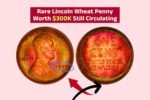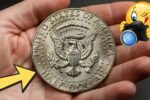Lincoln Wheat Penny Valued : Could a humble penny be your golden ticket? It sounds like a stretch, but coin collectors across the country are buzzing about a potential jackpot hiding in plain sight: a Lincoln Wheat Penny valued at $5.5 million. This isn’t fiction—it’s numismatic fact. A rare variation of this iconic coin could still be sitting in an old piggy bank, tucked in a forgotten drawer, or—yes—even floating around in everyday pocket change.
Here’s everything you need to know about this historic coin, why it’s so valuable, and how you can identify if you’ve struck copper-covered gold.
What Is the Lincoln Wheat Penny?
The Lincoln Wheat Penny (also known as the Wheat Cent) was first introduced in 1909 to honor the 100th anniversary of Abraham Lincoln’s birth. It remained in circulation until 1958, when the reverse design was changed to feature the Lincoln Memorial.
The reverse of the Wheat Penny showcases two stalks of wheat framing the words “ONE CENT” — a simple, classic design that became a mainstay in U.S. coinage. Though billions were minted, only a few are rare enough to fetch prices in the millions.
The $5.5 Million Mystery Penny
The coin rumored to be worth $5.5 million is not just any Wheat Penny. This astronomical value is linked to extremely rare varieties, most notably:
-
The 1943 Bronze Wheat Penny
-
The 1944 Steel Wheat Penny
-
High-grade uncirculated coins with mint errors or anomalies
In 1943, due to the war effort, the U.S. Mint produced pennies in steel to save copper for ammunition. However, a few bronze planchets (blanks) from 1942 were mistakenly used. These error coins are incredibly rare—only about 15–20 genuine examples are known to exist, and collectors are willing to pay millions for them.
In fact, one such 1943 bronze cent sold for $1.7 million, and a perfect-condition specimen has been estimated at $5 million or more in private collector circles. Add in provenance or historical interest, and the value can easily soar past $5.5 million.
How Can a Coin Like This Still Be in Circulation?
Many valuable coins survive undetected because:
-
People don’t closely examine pennies.
-
Older coins are often mixed with newer ones in circulation.
-
Estate sales, old coin jars, and inherited boxes can contain forgotten treasures.
While most of these rare coins have been found, a few may still be floating in circulation or tucked away in dusty collections—waiting to be discovered.
How to Identify a Rare Lincoln Wheat Penny
If you’re sorting through your change or old penny collections, here’s what to look for:
Check the Date and Mint Mark
-
1943 bronze penny (non-magnetic, reddish-brown tone)
-
1944 steel penny (magnetic, grayish-silver tone)
-
Look for rare combinations like 1909-S VDB, 1914-D, and 1922 “No D”
Test the Metal
-
Use a magnet: Steel pennies will stick; bronze/copper will not.
-
Weigh the coin: Bronze weighs about 3.11 grams, steel about 2.7 grams.
Inspect for Errors
-
Double dies (especially in the date or lettering)
-
Off-center strikes
-
Mismatched planchets or missing mint marks
Check the Condition
-
Coins in mint or uncirculated condition are far more valuable.
-
Do not clean the coin—it can destroy its value.
What to Do if You Think You Found One
-
Handle with care. Avoid fingerprints and store it in a soft cloth or coin flip.
-
Verify authenticity. Take it to a reputable coin dealer or submit it to a professional grading service like PCGS or NGC.
-
Get it appraised. Even common Wheat Pennies can be worth a few dollars depending on condition and date.
-
Explore your options. Rare coins often sell at auctions or through private collectors. Sites like Heritage Auctions and GreatCollections are great starting points.
Frequently Asked Questions (FAQs…)
Q1: Is there really a Lincoln Wheat Penny worth $5.5 million?
A: Yes—under very rare circumstances. The penny in question is likely a 1943 bronze Lincoln Wheat Penny, a rare mint error created when a few copper planchets were mistakenly used instead of steel. Depending on condition, provenance, and buyer demand, one of these can be valued up to or beyond $5.5 million.
Q2: Why is the 1943 bronze Lincoln penny so valuable?
A: In 1943, pennies were supposed to be made from steel due to World War II copper rationing. However, a small number were mistakenly struck on leftover bronze blanks from 1942. Only a handful are known to exist, making them exceptionally rare and highly valuable.
Q3: How can I tell if my 1943 penny is bronze or steel?
A:
-
Magnet test: Steel pennies stick to a magnet; bronze does not.
-
Color: Steel pennies are silvery gray; bronze ones have a reddish-brown or copper tone.
-
Weight: Bronze pennies weigh about 3.11 grams, steel pennies about 2.7 grams.
A penny may seem like the least valuable piece of currency—but in the world of coin collecting, it can be priceless. The Lincoln Wheat Penny is one of America’s most beloved coins, and certain rare versions like the 1943 bronze cent are veritable treasures.
So the next time you find a penny on the ground or empty your change jar, take a closer look. That tiny coin could be worth far more than one cent—it could be worth $5.5 million.
You never know. The next coin to change your life might already be in your hand.




